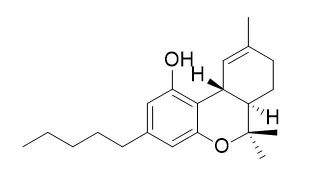| Description: |
Delta 9-tetrahydrocannabinol(THC) induces dopamine release in the human striatum, this allows new directions in research on the effects of THC in neuropsychiatric disorders, such as schizophrenia.
THC demonstrates an analgesic effect in patients experiencing cancer pain, it has antiemetic effect in patients receiving cancer chemotherapy. THC shows neuroprotection against ouabain-induced in vivo excitotoxicity, it promotes tumor growth by inhibiting antitumor immunity by a CB2 receptor-mediated, cytokine-dependent pathway. |
| In vivo: |
| Biological Psychiatry, 2005, 57(6):594-608. | | Delta-9-tetrahydrocannabinol effects in schizophrenia: implications for cognition, psychosis, and addiction.[Pubmed: 15780846] | Recent advances in the neurobiology of cannabinoids have renewed interest in the association between cannabis and psychotic disorders.
METHODS AND RESULTS:
In a 3-day, double-blind, randomized, placebo-controlled study, the behavioral, cognitive, motor, and endocrine effects of 0 mg, 2.5 mg, and 5 mg intravenous Delta-9-Tetrahydrocannabinol (Delta-9-THC) were characterized in 13 stable, antipsychotic-treated schizophrenia patients. These data were compared with effects in healthy subjects reported elsewhere. Delta-9-Tetrahydrocannabinol transiently increased 1) learning and recall deficits; 2) positive, negative, and general schizophrenia symptoms; 3) perceptual alterations; 4) akathisia, rigidity, and dyskinesia; 5) deficits in vigilance; and 6) plasma prolactin and cortisol. Schizophrenia patients were more vulnerable to Delta-9-THC effects on recall relative to control subjects. There were no serious short- or long-term adverse events associated with study participation.
CONCLUSIONS:
Delta-9-Tetrahydrocannabinol is associated with transient exacerbation in core psychotic and cognitive deficits in schizophrenia. These data do not provide a reason to explain why schizophrenia patients use or misuse cannabis. Furthermore, Delta-9-THC might differentially affect schizophrenia patients relative to control subjects. Finally, the enhanced sensitivity to the cognitive effects of Delta-9-THC warrants further study into whether brain cannabinoid receptor dysfunction contributes to the pathophysiology of the cognitive deficits associated with schizophrenia. | | Neuropsychopharmacology. 2009 Feb;34(3):759-66. | | Delta-9-tetrahydrocannabinol induces dopamine release in the human striatum.[Pubmed: 18754005] | The influence of cannabis on mental health receives growing scientific and political attention. An increasing demand for treatment of cannabis dependence has refueled the discussion about the addictive potential of cannabis.
A key feature of all addictive drugs is the ability to increase synaptic dopamine levels in the striatum, a mechanism involved in their rewarding and motivating effects. However, it is currently unknown if cannabis can stimulate striatal dopamine neurotransmission in humans.
METHODS AND RESULTS:
Here we show that Delta-9-Tetrahydrocannabinol (THC), the main psychoactive component in cannabis, induces dopamine release in the human striatum. Using the dopamine D(2)/D(3) receptor tracer [(11)C]raclopride and positron emission tomography in seven healthy subjects, we demonstrate that THC inhalation reduces [(11)C]raclopride binding in the ventral striatum and the precommissural dorsal putamen but not in other striatal subregions. This is consistent with an increase in dopamine levels in these regions.
CONCLUSIONS:
These results suggest that THC shares a potentially addictive property with other drugs of abuse. Further, it implies that the endogenous cannabinoid system is involved in regulating striatal dopamine release. This allows new directions in research on the effects of THC in neuropsychiatric disorders, such as schizophrenia. | | J Clin Pharmacol. 1975 Feb-Mar;15(2-3):139-43. | | Analgesic effect of delta-9-tetrahydrocannabinol.[Pubmed: 1091664] |
METHODS AND RESULTS:
A preliminary trial of oral Delta-9-Tetrahydrocannabinol (THC) demonstrated an analgesic effect of the drug in patients experiencing cancer pain. Placebo and 5, 10, 15, and 20 mg THC were administered double blind to ten patients. Pain relief significantly superior to placebo was demonstrated at high dose levels (15 and 20 mg).
CONCLUSIONS:
At these levels, substantial sedation and mental clouding were reported. | | N Engl J Med. 1975 Oct 16;293(16):795-7. | | Antiemetic effect of delta-9-tetrahydrocannabinol in patients receiving cancer chemotherapy.[Pubmed: 1099449] | Anecdotal accounts suggested that smoking marihuana decreases the nausea and vomiting associated with cancer chemotherapeutic agents.
METHODS AND RESULTS:
Oral Delta-9-Tetrahydrocannabinol was compared with placebo in a controlled, randomized, "double-blind" experiment. All patients were receiving chemotherapeutic drugs known to cause nausea and vomiting of central origin. Each patient was to serve as his own control to determine whether tetrahydrocannabinol had an antiemetic effect. Twenty-two patients entered the study, 20 of whom were evaluable. For all patients an antiemetic effect was observed in 14 of 20 tetrahydrocannabinol courses and in none of 22 placebo courses. For patients completing the study, response occurred in 12 of 15 courses of tetrahydrocannabinol and in none of 14 courses of placebo (P less than 0.001). No patient vomited while experiencing a subjective "high".
CONCLUSIONS:
Oral tetrahydrocannabinol has antiemetic properties and is significantly better than a placebo in reducting vomiting caused by chemotherapeutic agents. |
|






 Cell. 2018 Jan 11;172(1-2):249-261.e12. doi: 10.1016/j.cell.2017.12.019.IF=36.216(2019)
Cell. 2018 Jan 11;172(1-2):249-261.e12. doi: 10.1016/j.cell.2017.12.019.IF=36.216(2019) Cell Metab. 2020 Mar 3;31(3):534-548.e5. doi: 10.1016/j.cmet.2020.01.002.IF=22.415(2019)
Cell Metab. 2020 Mar 3;31(3):534-548.e5. doi: 10.1016/j.cmet.2020.01.002.IF=22.415(2019) Mol Cell. 2017 Nov 16;68(4):673-685.e6. doi: 10.1016/j.molcel.2017.10.022.IF=14.548(2019)
Mol Cell. 2017 Nov 16;68(4):673-685.e6. doi: 10.1016/j.molcel.2017.10.022.IF=14.548(2019)